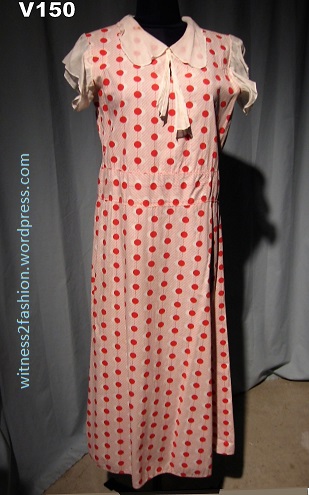
This vintage dress has been altered and patched. It raises many questions.
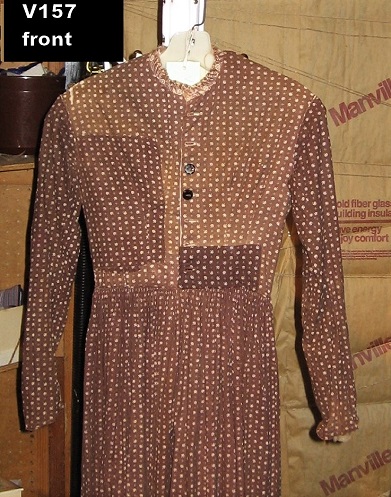
The patches on this faded dress hint at a life of hardship. If I had photographed the back, dating it might be possible — but a poor woman might not have had access to current fashions. It’s a mystery to me.
Many collectors are interested in the beauty of vintage dresses. But the woman who collected these dresses saw them as windows into women’s lives. Sadly, neither dress had documentation, so we don’t know anything about the women who made them, wore them, patched them, and tried to make them last a few more months or years. I’m sharing them because such dresses rarely survive to be collected — they end in the rag bag, not a museum. I don’t have the expertise even to date them securely (and how I wish I had had time to take more pictures!) Comments and conjectures about them are very welcome.
A mystery dress circa 1930?
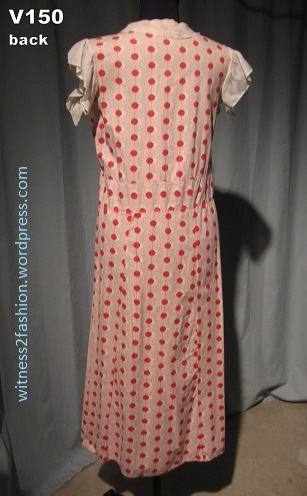
Back of red dotted dress with a puzzling insert at the waist.
Here’s the front again:

Is this a late twenties dress, lengthened as much as possible for the 1930s? Or is it a thirties dress, lengthened and altered for a new wearer?
It is very long, suggesting early 1930s. There’s no fading to mark a previously shorter hem line, but this hem is as skimpy as possible. Was it a hand-me-down from a shorter woman?
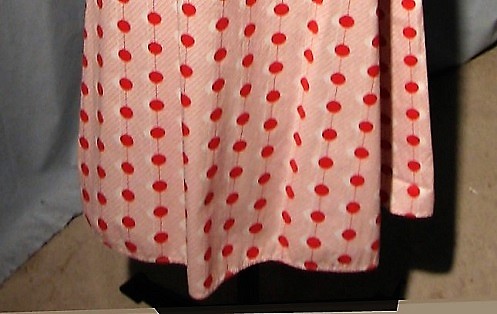
A tiny rolled hem.
This dress was home-made, and not by a very accomplished seamstress. Here’s the sheer collar:
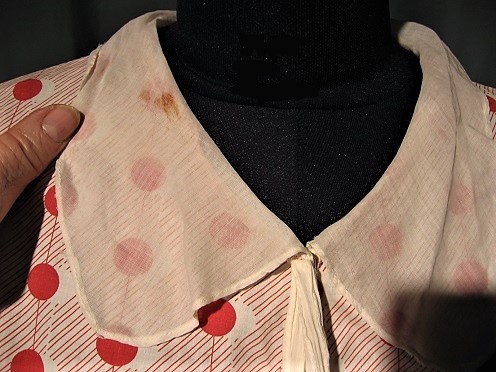
The rolled hem on this collar is machine stitched, but quite uneven.
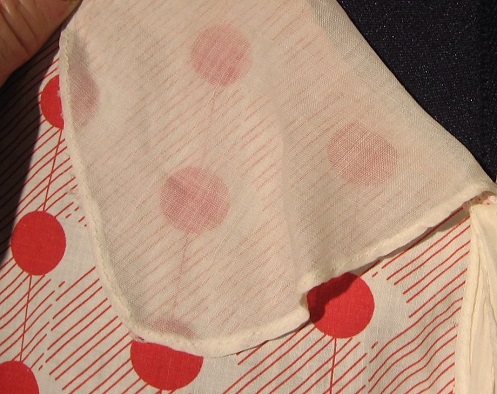
Maintaining even tension around the curve of a soft, sheer material isn’t easy.
Someone who worked on this dress didn’t cut perfectly on grain, so the skirt sags towards its right side. You can see that the vertical pattern of dots on the front of the dress lined up originally. Was there always a waist seam? It doesn’t look like it.
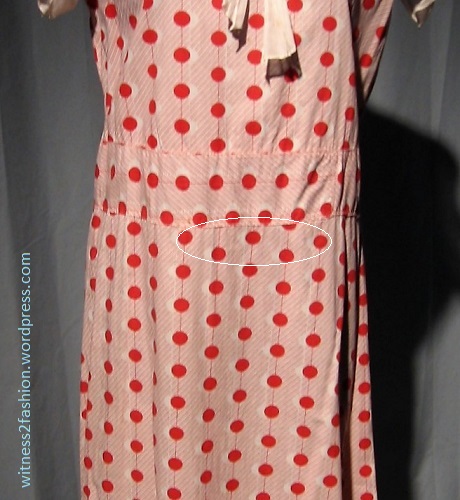
The slightest sag at the waist seam (the dots don’t line up evenly) affects the hang of the skirt. Did this happen originally, or when the wide piece was inserted? Was the front of this dress one piece from shoulder to hem before it was altered?

The pattern of dots isn’t straight because the skirt is off grain at the waist.
There are seams in the back of the dress:
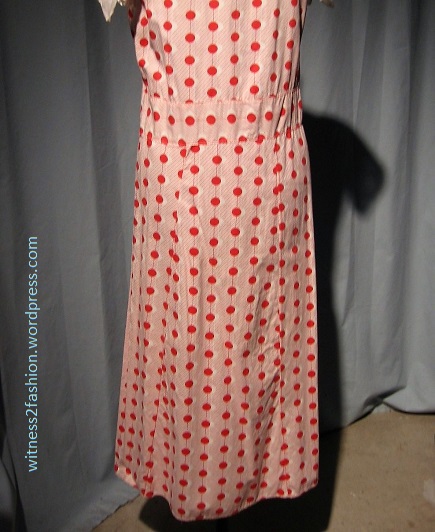
Vertical back seams suggest that the dress always had a waist seam in back — or do they? I’m asking….
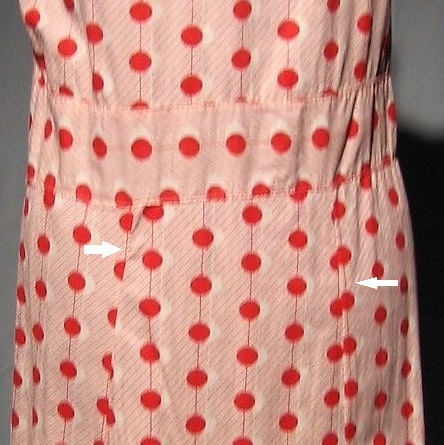
Again, this pattern matching is not the work of an experienced dressmaker. On the other hand, I once bought cheap printed flannel plaid for a nightgown and discovered that it was printed off grain, so it was possible to make perfectly matched seams on one side but not on the other. Maybe it was hard to fold this material for cutting and make the dots line up.
Aside from the question of why this dress has a wide band inserted at the waist, it’s clear that the person doing the alterations had barely enough material for the band — not enough to match the dots and line them up inconspicuously. In fact, the stripes on the dress run vertically and those on the band run horizontally. It’s made from scraps.
Scraps were also needed for alterations to the armholes. Either they tore while the dress was being worn, or they had to be enlarged for a different wearer:
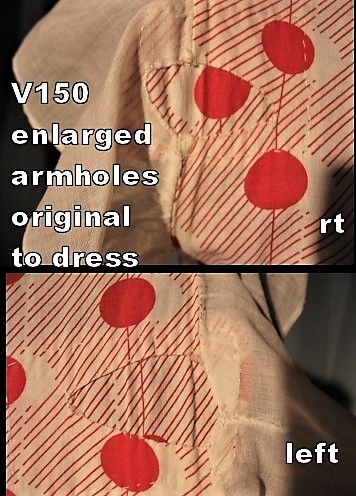
On each side, the armhole was made larger and a patch was placed underneath. The repairs to the sheer ruffle are not symmetrical. Did one side tear?
Presumably there wasn’t enough fabric to match the pattern — or the person making the alternations wasn’t skilled enough to try (these are very large patches, secured with another line of large hand stitches.
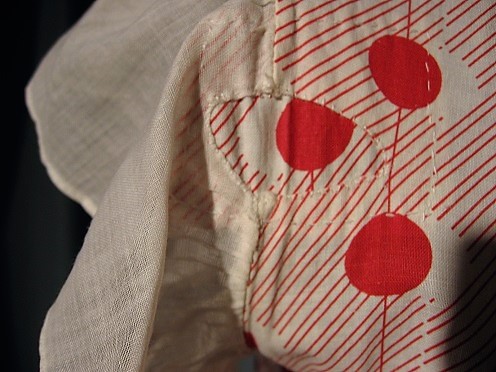
I’m not belittling the people who made and altered this dress. I’m suggesting that they did not have the luxury of perfectionism. They had to make do with what they had, and I think that whoever owned this dress, new or second-hand, had to wear it and hold her head high. Poverty limits choices.
Another mystery dress, probably 19th century (?)
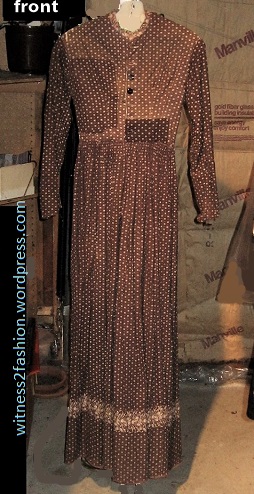
The front of a long dress with fitted bodice and many patches.
Perhaps the most striking thing about this dress is that the patches accumulated over time. It appears to be patched with scraps of the original fabric, but the dress, the large patch, and the smaller patch are not faded equally. The fabric is lightweight, so the cream colored bodice lining contributes to the impression of fading there, but not on the sleeves.
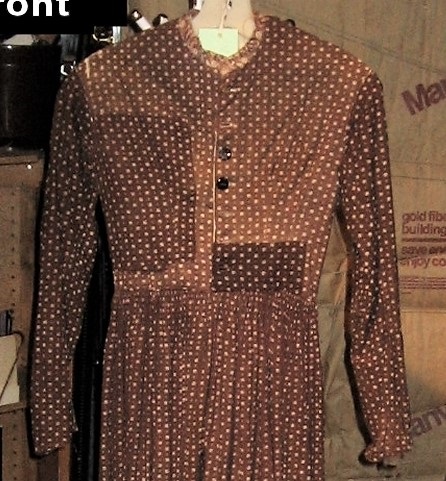
How I wish I had had a mannequin available, and the time to photograph the back and the interior structure. The back seams would tell us something about the date when it was made. The waist seems to be cartridge pleated, but, again, I have no photo of the construction. The shoulders don’t look dropped, but it’s hard to tell on a big, padded coat hanger!
The neckline is crudely done, using fabric that matches the band on the skirt.
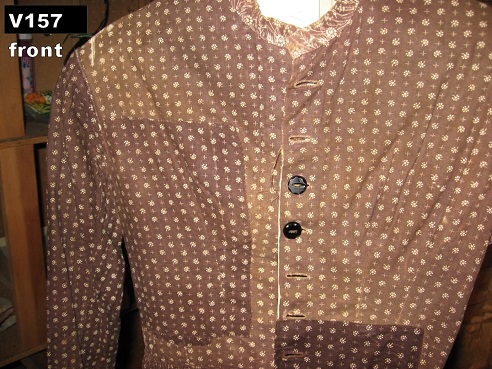
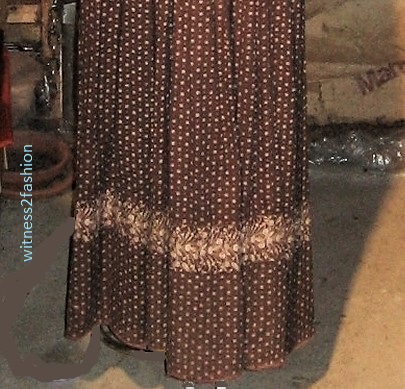
The hem is very worn, and the fabric at the shoulders is faded and worn through in one place.
It is possible to see two bust darts on the left side of the bodice (on its right, they are hidden by a patch.)
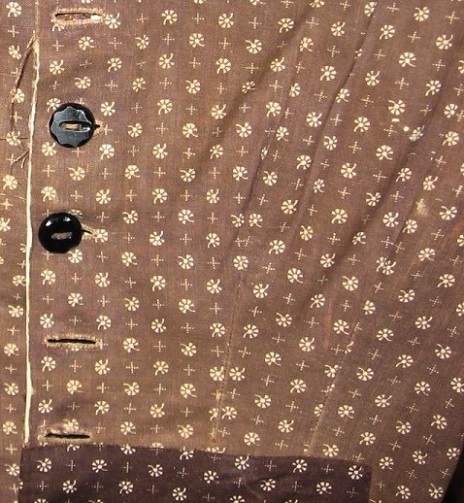
You can see characteristic Victorian bust darts which are not covered by the dark patch.
But the dress is a mystery as to date, especially because, if it was made and worn by a rural woman, she could have been using a much older dress as her only guide. Machine stitched or hand stitched? Or both? I don’t know.
Someone may recognize the fabric, or be able to date the dress from old photographs — for me, it’s a nagging mystery — and I wish I knew about the woman who wore it. To me, the dress says that she was strong and brave while enduring years of hardship.
